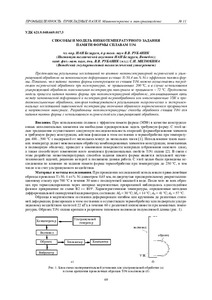Please use this identifier to cite or link to this item:
https://elib.psu.by/handle/123456789/14393Full metadata record
| DC Field | Value | Language |
|---|---|---|
| dc.contributor.author | Рубаник, В. В. | - |
| dc.contributor.author | Рубаник, В. В. мл. | - |
| dc.contributor.author | Милюкина, С. Н. | - |
| dc.date.accessioned | 2015-11-05T12:55:03Z | - |
| dc.date.available | 2015-11-05T12:55:03Z | - |
| dc.date.issued | 2015 | - |
| dc.identifier.citation | Вестник Полоцкого государственного университета. Серия B, Промышленность. Прикладные науки. - 2015. - № 11. - С. 69-76. | ru_RU |
| dc.identifier.issn | 2070-1616 | - |
| dc.identifier.uri | https://elib.psu.by/handle/123456789/14393 | - |
| dc.description.abstract | Представлены результаты исследований по влиянию низкотемпературной термической и ультразвуковой обработки на запоминаемую деформацию в сплаве Ti-50,4 ат.% Ni с эффектом памяти формы. Показано, что задание памяти формы конструкциям из сплавов TiNi можно осуществлять посредством термической обработки при температурах, не превышающих 200 ºС, а в случае использования ультразвуковой обработки максимальная температура материала не превышает ~ 72 ºС. Предложена модель процесса задания памяти формы при низкотемпературной обработке, устанавливающая связь между запоминаемой деформацией и температурой термообработки или интенсивностью УЗК и продолжительностью обработки, которая подтверждается результатами теоретических и экспериментальных исследований зависимостей температуры окончания обратного мартенситного превращения в напряженном материале. Разработаны низкотемпературные способы обработки сплавов TiNi для задания памяти формы с спользованием термической или ультразвуковой обработки. = The research results of low-temperature heat and ultrasonic treatment on setting strain in the samples of Ti-50,4 at.% Ni alloy with shape memory are presented in this paper. It is found that shape memory setting of TiNi actuators can be carried out by heat treatment at temperatures not exceeding 200 °C, and in the case of using ultrasonic treatment the maximum temperature will not be higher than ~ 72 °C. We offer a model of the low-temperature shape memory setting process, that establishes a connection between the setting strain and heat treatment temperature or the intensity of ultrasonic vibrations and treatment duration and confirmed by the results of theoretical and experimental investigations of the finish reverse martensite transformation temperature in a stressed material. The low-temperature methods of TiNi alloys processing for shape memory setting by heat or ultrasonic treatment are developed. | ru_RU |
| dc.language.iso | ru | ru_RU |
| dc.publisher | Полоцкий государственный университет | ru_RU |
| dc.relation.ispartof | Веснік Полацкага дзяржаўнага ўніверсітэта. Серыя B, Прамысловасць. Прыкладныя навукі | be_BE |
| dc.relation.ispartof | Herald of Polotsk State University. Series B, Industry. Applied Sciences | en_EN |
| dc.relation.ispartof | Вестник Полоцкого государственного университета. Серия B, Промышленность. Прикладные науки | ru_RU |
| dc.relation.ispartofseries | Серия B, Промышленность. Прикладные науки;2015. - № 11 | - |
| dc.rights | open access | ru_RU |
| dc.subject | Государственный рубрикатор НТИ - ВИНИТИ::ТЕХНИЧЕСКИЕ И ПРИКЛАДНЫЕ НАУКИ. ОТРАСЛИ ЭКОНОМИКИ::Металлургия | ru_RU |
| dc.subject | Обработка сплавовTiNi | ru_RU |
| dc.subject | модель процесса задания памяти формы | ru_RU |
| dc.subject | эффект памяти формы | ru_RU |
| dc.subject | низкие температуры | ru_RU |
| dc.title | Способы и модель низкотемпературного задания памяти формы сплавам TiNi | ru_RU |
| dc.title.alternative | Methods and Model of Low-Temperature Shape Memory Setting in Tini Alloys. | - |
| dc.type | Article | ru_RU |
| dc.identifier.udc | 621.9.048:669.017.3 | - |
| Appears in Collections: | 2015, № 11 | |
Items in DSpace are protected by copyright, with all rights reserved, unless otherwise indicated.
